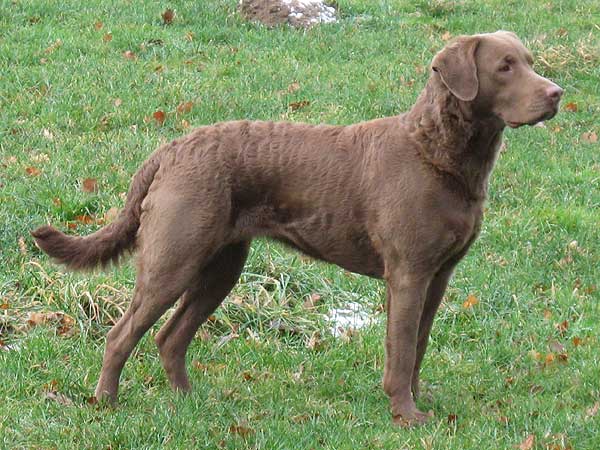
Chesapeake Bay Retriever

Navigate through the tabs
Navigate through the tabs below to view the breed's info of your interest.
The breed's info is divided in four sections; namely:
the breed's history ,
the breed's main stats ,
the dog's potential health issues
and finally, how the breed scored in 26 different categories.
All the above information should give you a respectively good overview for the dog of your interest.
Dog Breed's Main Info
The Breed's History:
Chesapeake Bay Retrievers trace their history to two pups who were rescued from a foundering ship in Maryland in 1807. The male "Sailor" and female "Canton" were described as Newfoundland dogs, but were more accurately Lesser Newfoundland or St. John's water dogs.
These two lived in different parts of the bay area and there is no record of a litter being produced together.
They were bred with area dogs, with more consideration given to ability than to breed, to create the beginnings of the Chesapeake Bay Retriever breed.
There are few records of the breeds of these early dogs, but spaniels and hounds were included. Dogs from both Chesapeake Bay shores were recognized as one of three types of Chesapeake Bay Ducking Dog in 1877.
In 1918 a single type, called the Chesapeake Bay Retriever, was recognized by the American Kennel Club, and there have been few changes to the breed standard since then.
In 1964, it was declared the official dog of Maryland.
It is the mascot of the University of Maryland, Baltimore County. Members of the breed were owned by General George Armstrong Custer, President Theodore Roosevelt, and actors Paul Walker and Tom Felton.
Country of Origin:
United States
Breed Group:
Sporting
Height:
1 foot, 9 inch. to 2 fet, 2 inch. (53,34 to 66,04 cm)
Weight:
55 to 80 pounds (24,95 to 36,29 Kg)
Life Span:
10 to 12 years
Potential Health Issues:
Hip Dysplasia,
Von Willebrand's Disease,
Progressive Retinal Atrophy (PRA),
Gastric Dilatation-Volvulus (Bloat),
Epilepsy,
Chondrodysplasia
Adaptability
Apartment Living:
First Time Owners:
Sensitivity:
Being Alone:
Cold Weather:
Hot Weather:
Friendliness
Affection With Family:
With Kids:
With Dogs:
With Strangers:
Health and Grooming
Shedding:
Drooling:
Easy To Groom:
Overall Health:
Weight Gain Potential:
Size:
Training
Easiness:
Intelligence:
Mouthiness:
Prey Drive:
Barking or Howling:
Wanderlust:
Need For Exercise
Energy Level:
Intensity:
Exercise Needs:
Playfulness:
Our Mobile Application
Check out Our Mobile Application "Dog Breeds Central"
